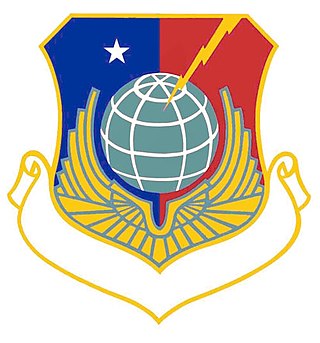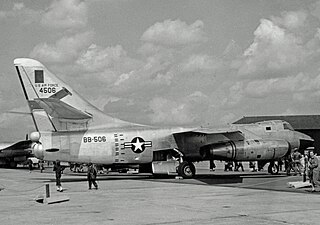
The 320th Air Expeditionary Wing is a provisional United States Air Force unit assigned to the Air Force District of Washington. It is stationed at Bolling AFB, District of Columbia. The 320 AEW may be activated or inactivated at any time.

The 398th Air Expeditionary Group is a provisional United States Air Force unit assigned to the United States Air Forces in Europe. The 398 AEG may be activated or inactivated at any time.

The 323rd Air Expeditionary Wing is a provisional United States Air Force unit assigned to the United States Air Forces in Europe. As a provisional unit, it may be activated or inactivated at any time.

The 453rd Bombardment Group is an inactive United States Air Force unit that was first organized in June 1943, during World War II, as a Consolidated B-24 Liberator heavy bomber group. After training in the United States, it deployed to England in December 1943, and, starting in February 1944, participated in the strategic bombing campaign against Germany with Eighth Air Force. Its 733d Bombardment Squadron completed 82 consecutive missions without a loss, a record for Eighth Air Force bomber units. James Stewart, of film fame, was group operations officer from 31 March to 1 July 1944. The group was programmed for redeployment to the Pacific and returned to the United States in May 1945 for training, however the Japanese surrender cancelled these plans and the group was inactivated in September 1945.

The 19th Electronic Warfare Squadron is an active United States Air Force unit, stationed in Bann, Germany as part of the United States Air Forces in Europe Warrior Preparation Center. It was first activated during World War II as the 19th Photographic Mapping Squadron. During the war, the squadron remained in the United States and mapped areas of North America. However, starting in 1944, the air echelon of the squadron deployed to North Africa to map that area. After V-E Day, the squadron moved to England and mapped large areas of Europe until October 1945, when it began to stand down for inactivation. It was briefly active in the reserve from 1947 to 1949 as the 19th Reconnaissance Squadron.

The 512th Rescue Squadron is part of the 58th Special Operations Wing based at Kirtland Air Force Base, New Mexico. It formerly operated the Bell UH-1N Twin Huey and currently operates the Sikorsky HH-60G Pave Hawk and the new HH-60W Jolly Green II helicopters training aircrew conducting search and rescue missions.

The 449th Expeditionary Flying Training Squadron is a provisional United States Air Force unit. It was first activated as the 449th Bombardment Squadron in July 1942. After training in the United States, it deployed to the European Theater of Operations (ETO) in December 1942. It engaged in combat operations from 1943 to 1945, earning a Distinguished Unit Citation for demonstrating the effectiveness of medium bombers in the ETO. Following V-E Day, it participated in the disarmament of the Luftwaffe, until September 1945, when it returned to the United States for inactivation.

The 450th Expeditionary Flying Training Squadron is a provisional United States Air Force unit. The squadron was first activated as the 450th Bombardment Squadron in July 1942. After training in the United States, it deployed to the European Theater of Operations (ETO) in December 1942. It engaged in combat operations from 1943 to 1945, earning a Distinguished Unit Citation for demonstrating the effectiveness of medium bombers in the ETO. Following V-E Day, it participated in the disarmament of the Luftwaffe until September 1945, when it returned to the United States for inactivation.

The 820th Bombardment Squadron is a former Army Air Forces unit, inactivated on 4 January 1946. The squadron was first activated during World War II as the 521st Bombardment Squadron. The squadron was soon engaged in the antisubmarine campaign off the Atlantic coast of the United States as the 16th Antisubmarine Squadron.

The squadron was organized in March 1942 as the 380th Bombardment Squadron and trained in the Southeastern United States with North American B-25 Mitchells. In September, the air echelon of the unit moved to the United Kingdom in preparation for Operation Torch, the allied invasion of North Africa. In November, the squadron was reunited in French Morocco. It continued in combat in the Mediterranean Theater of Operations until V-E Day, earning two Distinguished Unit Citations. It was inactivated in September 1945 in Italy.

The 318th Cyberspace Operations Group is a United States Air Force information operations unit located at Joint Base San Antonio, Texas. The group was first activated during World War II as the 8th Photographic Reconnaissance Group. After training in the United States, the unit moved to the China-Burma-India Theater and engaged in hostilities until the end of the war. It returned to the United States in November 1945, and was inactivated at the port of embarkation.

The 53rd Electronic Warfare Group was a component of the 53rd Wing of the Air Force Warfare Center, Air Combat Command, headquartered at Eglin Air Force Base, Florida.

The 513th Electronic Warfare Squadron is a United States Air Force unit assigned to the 350th Spectrum Warfare Group at Eglin Air Force Base, Florida.

The 323d Strategic Reconnaissance Squadron is an inactive United States Air Force unit. Its last was assigned to the 91st Strategic Reconnaissance Wing, stationed at Lockbourne Air Force Base, Ohio. It was inactivated on 8 November 1957.

The 451st Flying Training Squadron is an active United States Air Force unit. It is assigned to the 479th Flying Training Group, stationed at Naval Air Station Pensacola, Florida. The squadron was first activated as the 451st Bombardment Squadron in July 1942. After training in the United States, it deployed to the European Theater of Operations (ETO) in December 1942. It engaged in combat operations from 1943 to 1945, earning a Distinguished Unit Citation for demonstrating the effectiveness of medium bombers in the ETO. Following V-E Day, it participated in the disarmament of the Luftwaffe until September 1945, when it returned to the United States for inactivation.

The 456th Bombardment Squadron is one of the two predecessors of the 556th Tactical Air Support Squadron, an inactive United States Air Force unit. Formed in 1985 by the consolidation of the 456th with another inactive bombardment squadron. It has never been active under its most recent designation.

The 454th Flying Training Squadron is an inactive United States Air Force unit. It was last assigned to the 323d Flying Training Wing at Mather Air Force Base, California, where it was inactivated on 31 May 1993.

The 455th Flying Training Squadron is a United States Air Force unit of Air Education and Training Command. It was most recently activated at NAS Pensacola as part of the 479th Flying Training Group, where it trains Combat Systems Officers with the Raytheon T-6 Texan II.

The squadron was the 739th Bombardment Squadron, which was activated in June 1943. After training in the United States with the Consolidated B-24 Liberator, the 739th deployed to the Mediterranean Theater of Operations, participating in the strategic bombing campaign against Germany. It earned two Distinguished Unit Citations for its combat operations. Following V-E Day, the squadron returned to the United States for conversion as a very heavy bomber unit, but was inactivated instead.

The 323d Expeditionary Operations Group is a provisional United States Air Force unit assigned to the United States Air Forces in Europe. As a provisional unit, it may be activated or inactivated at any time.
























